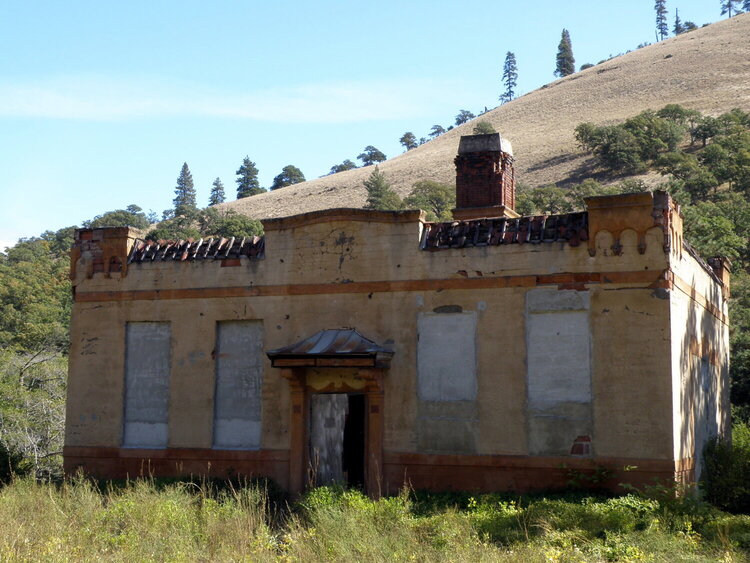Plus, a FREE Gift! | Details Here.


 Give a Cheer
Give a Cheer
9-21-10...This building has quite a history...too much for me to re-type so I'll copy some info on it. I probably don't need to tell you that the part about the birds really grabbed my attention. [P9216640]
~~~~~~~~~~~~~~~~~~~~~~~~~~~~~~~~~~~~~~
The Goldendale Sentinel, Goldendale, WA., May 27, 1982, page 5
Includes photograph titled:
KLICKITAT ICE PLANT - Built in the 1930's as a bottling plant for mineral water, the building was the Gas-Ice Corporation of Washington for many years. Local petitioners saved the structure and the plant is now a bird sanctuary for swallows.
KLICKITAT ICE PLANT
1930's Architecture Along The Banks Of The Klickitat River Provides Sanctuary For Chimney Swifts
Now a sanctuary for 'chimney swifts', or swallows, the old ice plant, in Klickitat bears little resemblance to the former site of the Gas-Ice Corporation erected in the 1930's.
The buildings were first erected by a Mr. Langdon, of Walla Walla, who planned to use the Klickitat site as a bottling plant for the local mineral water. The bubbling liquid was found on the property. He received a contract with Safeway to sell the water. Old-timer, Homer Mitchell, of Klickitat recalls passenger trains stopping at Klickitat for a drink of the popular beverage.
Local people were, 'real glad to get it', according to Zillah Huntington, another pioneer. The problem was the water was often go flat and the contents would blow up before people traveled to Lyle.
After Langdon's death, Raymond B. Newbern, also of Walla Walla, was called into investigate the situation.
Discovering there was no market for mineral water, he discovered another product. Working with Claire P. Holdrege, a geologist, the duo formed the Gas-Ice Corporation of Washington, for the sale and manufacture of dry ice.
The early form of refrigeration was employed throughout the country and after several years the company was producing up to 18 tons per day. The Klickitat Plant was also noted for its storage capacity. Its output was the manufacturing of over 700,000 pounds in the spring and sold during the peak summer season.
Mitchell, recalls the plant running two or three shifts per day. Youths from the area often were employed wrapping the 80-pound packages for shipment throughout the country. In the plant's early days, railroads transported the ice.
Former customer, Mrs. Huntington, said 'A little known fact about the plant is the gas tanks used by the company were also used by the United States Navy during the Second World War'.
Both Mrs. Huntington and Mitchell talked about the annual summer fish feeds, held at the ice plant. 'Up to as many as 300 people would eat 600 pounds of smoked fish', said Mitchell. People would drink beer and occasionally dance in this 60 by 80 foot storage building. The feeds were discontinued after the Second World War.
The war brought many changes to the area. As more people moved into the area, there was an increase of workers. These additional employees became involved with the unions. The Newberns, a conservative Southern family preferred to keep the business within the family.
According to Mitchell the changes were 'viciously resisted by the Newberns.'
The Newbern's sold the plant and the grounds after their son was drowned.
The plant remained empty for many years. The State Game Division took over the area and all, but one of the buildings destroyed.
A petition by local residents established the remaining structure, the furnace house, as a sanctuary for the birds who roost in the chimneys. The fall migration of the swallows brings many visitors to the area.
The birds are unaware of the plant's history. Now, the interior of the building has cracked ceilings and a floor that sags. Sagging couches and cabinets hanging from loose hinges are the only remains of the plant. The 'no trespassing signs' do little to discourage the curious.
For the old-timers of Klickitat there are the memories of the ice plant. For new residents there is still a story to be told.
[HOME]
© Jeffrey L. Elmer
Information copied from: homepages.rootsweb.ancestry.com
No products have been added to this project.
Thanks for spreading positivity!
September 27, 2010
September 25, 2010
September 24, 2010
September 24, 2010
September 24, 2010
September 24, 2010
September 23, 2010
September 23, 2010
September 23, 2010
September 23, 2010